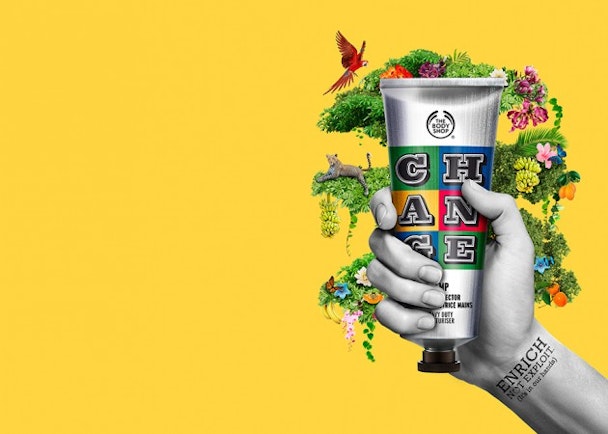How marketing will help The Body Shop become the world's most ethical and sustainable brand
The Body Shop recently announced an ambitious plan to become “the most ethical and truly sustainable global business”. The Drum caught up with director of commitment and corporate comms, Kate Levine, to find out how the beauty retailer plans use its marketing prowess to get there.

The Body Shop’s business has been built on giving back to communities. Founded by the late Anita Roddick 40 years ago she pioneered the idea that a successful business could simultaneously be a force for good and positive change. However, since a buyout from L'Oreal followed by Roddick’s death in 2007 and the injection of a new chief executive - coupled with a general trend for companies to invest more effort into their CSR strategies (and shout loudly about it) - by The Body Shop’s own admission it’s been comparatively “quieter” in the last few years.
“That doesn’t mean we haven’t been doing things,” Kate Levine, director of commitment (a new role at the company) and corporate communications, recently told The Drum.
“We had a Stop Sex Trafficking campaign which delivered seven million signatures to the UN and changed laws in 20 countries. And in 2013 we were instrumental in changing laws on animal testing. We just haven’t talked about it in the way we were in the past.”
That’s about to change.
The retail giant took a hard look last year at how it could become fit for the future and the kind of impact it wanted to have over the next 40 years.
It’s come up with a list of targets for 2020 under the new philosophy of ‘Enrich Not Exploit’, including making sure that every one of its natural ingredients are traceable and sustainably sourced, developing new packaging that doesn’t contain fossil fuels, and reducing the environmental footprint across all of its stores.
Where most chief executives are only just now realising the commercial value in creating a business with purpose beyond profit, The Body Shop has been guided by this since conception and is acutely aware of the impact telling the story behind these goals will have on its bottom line.
“Brands with purpose are the brands that consumers have stronger loyalty for. They’re not buying the product or the service, they’re buying the ethos,” said Levine. And so making sure The Body Shop’s marketing vision is as comprehensive as the goals it has set out has been a priority.
With a global staff of over 22,000 some of the most important communications around ‘Enrich Not Exploit’ have happened behind closed doors. To keep employees around the world – from the top to the bottom of the company- in the loop it created a campaign, starting with a teaser video and culminating in a full-length film outlining its ambitions and how each person could help.
Next up came a redesign of its stores. In the longer term The Body Shop is investing heavily in making every retail outlet eco-friendly by using locally-sourced SSC-certified wood, sustainable materials in its flooring, LED lighting and non-toxic paints. However, to make consumers aware of 'Enrich not Exploit' in the shorter term it's made some more cosmetic changes including the introduction of a vibrant yellow colour-scheme and eye-catching front window featuring a specially designed symbol (shown above).
To show shoppers the impact that every pound spent with The Body Shop has on the wider world, it's put one square meter of faux-grass on at the checkout point which the customer stands on as they pay to see what they're helping to build.
This idea of being able to physically see where spend with The Body Shop's goes will be taken further with web-cams which show things like where ingredients are being grown.
"We're working on it now for later in the year, around October," said Levine. "It's kind of like when you make a donation through Just Giving, you can see that barometer. We’re still working out the detail but there will be something where you can see your contribution."
Chief executive Jeremy Schwartz has also outlined ambitions to make transactions completely paperless (and cashless). He's working towards a system when customers pay on their phones and immediately receive a receipt and loyalty points to the same device.
The Body Shop's next big marketing burst will come in June with a Bio-Bridge project that aims to reconnect bio-diverse habitats where communities or habitats have become separated. A campaign called 'Help Reggie Find a Date' and stars an endangered red-shanked douc from Vietnam called Reggie and will draw attention to The Body Shop's efforts to build a bridge between the two islands cut-off from each other where the money's live. By bridging the gap, it's hoped the population of the species will begin to increase.

Much like The Body Shop's campaigns of the past, it will focus less on putting marketing pounds behind TV and instead plans to create a lot of video, in-store, and social media content. With 65 per cent of its shoppers under 35 years old, the brand has been increasingly testing emerging channels like Snapchat, Instagram and Pinterest which Levine said is working well.
Ultimately though, Levine's thoughts on the role of marketing comes back to simply making sure its renewed ethos is never far from mind: "What we want consumers to think is 'I want this and I know when I buy it no person, animal or plant has been exploited and I’m buying it from a company doing a good thing”.

